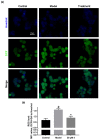Design, Synthesis and Biological Evaluation of α-Synuclein Proteolysis-Targeting Chimeras
- PMID: 37298935
- PMCID: PMC10254247
- DOI: 10.3390/molecules28114458
Design, Synthesis and Biological Evaluation of α-Synuclein Proteolysis-Targeting Chimeras
Abstract
α-Synuclein aggregation under pathological conditions is one of the causes of related neurodegenerative diseases. PROTACs (proteolysis targeting chimeras) are bifunctional small molecules that induce a post-translational erasure of proteins via the ubiquitination of target proteins by E3 ubiquitin ligase and subsequent proteasomal degradation. However, few research studies have been conducted for targeted protein degradation of α-synuclein aggregates. In this article, we have designed and synthesized a series of small-molecule degraders 1-9 based on a known α-synuclein aggregation inhibitor sery384. In silico docking studies of sery384 with α-synuclein aggregates were accomplished to ensure that the compounds bound to α-synuclein aggregates specifically. The protein level of α-synuclein aggregates was determined to evaluate the degradation efficiency of PROTAC molecules on α-synuclein aggregates in vitro. The results show that compound 5 had the most significant degradation effect, with DC50 of 5.049 μM, and could induce the degradation of α-synuclein aggregates in a time- and dose-dependent manner in vitro. Furthermore, compound 5 could inhibit the elevation of the ROS level caused by overexpression and aggregation of α-synuclein and protect H293T cells from α-synuclein toxicity. Conclusively, our results provide a new class of small-molecule degraders and an experimental basis for the treatment of α-synuclein related neurodegenerative diseases.
Keywords: PROTAC (proteolysis-targeting chimera); protein aggregates; α-synuclein.
Conflict of interest statement
The authors declare no conflict of interest.
Figures






Similar articles
-
Discovery of Small-Molecule Degraders for Alpha-Synuclein Aggregates.J Med Chem. 2023 Jun 22;66(12):7926-7942. doi: 10.1021/acs.jmedchem.3c00274. Epub 2023 Jun 2. J Med Chem. 2023. PMID: 37267712
-
Discovery of Effective Dual PROTAC Degraders for Neurodegenerative Disease-Associated Aggregates.J Med Chem. 2024 Mar 14;67(5):3448-3466. doi: 10.1021/acs.jmedchem.3c01719. Epub 2024 Feb 14. J Med Chem. 2024. PMID: 38356330
-
Degradation of neurodegenerative disease-associated TDP-43 aggregates and oligomers via a proteolysis-targeting chimera.J Biomed Sci. 2023 Apr 26;30(1):27. doi: 10.1186/s12929-023-00921-7. J Biomed Sci. 2023. PMID: 37101169 Free PMC article.
-
Proteolysis-targeting chimeras (PROTACs) in cancer therapy.Mol Cancer. 2022 Apr 11;21(1):99. doi: 10.1186/s12943-021-01434-3. Mol Cancer. 2022. PMID: 35410300 Free PMC article. Review.
-
E3 ligase ligand chemistries: from building blocks to protein degraders.Chem Soc Rev. 2022 May 10;51(9):3487-3534. doi: 10.1039/d2cs00148a. Chem Soc Rev. 2022. PMID: 35393989 Review.
Cited by
-
The Peptide PROTAC Modality: A New Strategy for Drug Discovery.MedComm (2020). 2025 Mar 24;6(4):e70133. doi: 10.1002/mco2.70133. eCollection 2025 Apr. MedComm (2020). 2025. PMID: 40135198 Free PMC article. Review.
-
Targeted protein degradation: advances in drug discovery and clinical practice.Signal Transduct Target Ther. 2024 Nov 6;9(1):308. doi: 10.1038/s41392-024-02004-x. Signal Transduct Target Ther. 2024. PMID: 39500878 Free PMC article. Review.
-
Targeted degradation of α-synuclein by arginine-based PROTACs.J Biol Chem. 2025 Jul 2;301(8):110449. doi: 10.1016/j.jbc.2025.110449. Online ahead of print. J Biol Chem. 2025. PMID: 40615042 Free PMC article.
-
Perspective Strategies for Interventions in Parkinsonism: Remedying the Neglected Role of TPPP.Cells. 2024 Feb 14;13(4):338. doi: 10.3390/cells13040338. Cells. 2024. PMID: 38391951 Free PMC article.
-
Advancements in Proteolysis Targeting Chimeras for Targeted Therapeutic Strategies in Alzheimer's Disease.Mol Neurobiol. 2025 Aug;62(8):9686-9709. doi: 10.1007/s12035-025-04838-0. Epub 2025 Mar 25. Mol Neurobiol. 2025. PMID: 40133753 Free PMC article. Review.
References
-
- Dehay B., Bourdenx M., Gorry P., Przedborski S., Vila M., Hunot S., Singleton A., Olanow C.W., Merchant K.M., Bezard E., et al. Targeting α-synuclein for treatment of Parkinson’s disease: Mechanistic and therapeutic considerations. Lancet Neurol. 2015;14:855–866. doi: 10.1016/S1474-4422(15)00006-X. - DOI - PMC - PubMed
MeSH terms
Substances
Grants and funding
LinkOut - more resources
Full Text Sources

